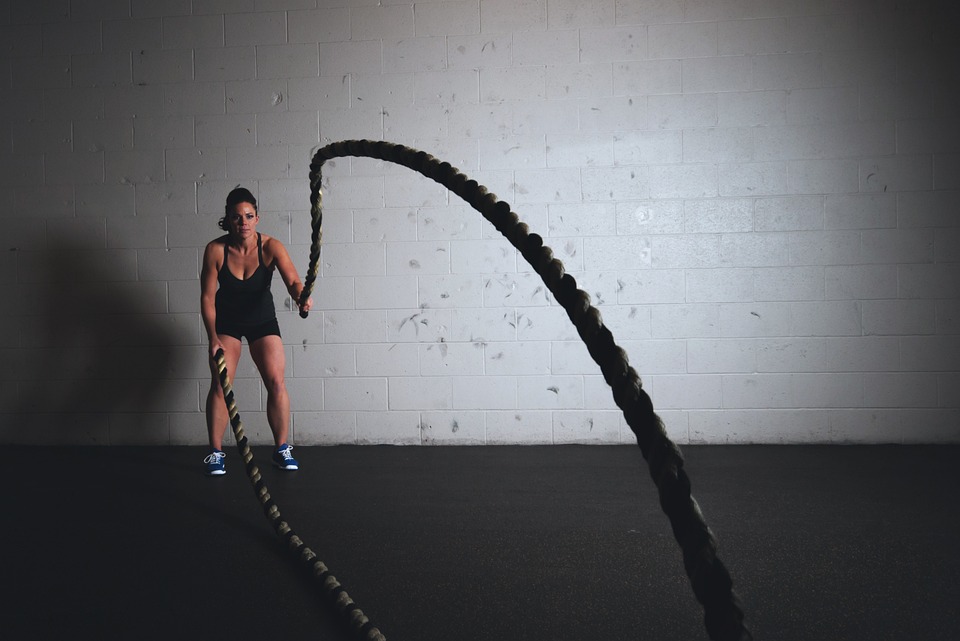Trimming body fat isn’t a goal exclusive to bodybuilders and fitness pros. From stay-at-home moms to dedicated gym goers, many of us strive to burn fat and improve our body composition. However, just because you commit to a fat-burning practice doesn’t mean you’re putting your body in the best position.
In fact, there are many common strategies supposedly aimed at burning fat that simply aren’t supported by research. We’re here to not only shed some light on the truth about several popular fat-burning myths, but also steer you in the right direction so you can achieve your goals.
WHY BURNING FAT CAN BE A CHALLENGE
Life’s stressful. On top of paying bills, taking care of the kids or whatever responsibilities are on your proverbial plate, there’s a constant battle of trying to burn fat while keeping our waistlines in check. As anyone with a busy schedule knows, it can be difficult to consistently make the right choices when it comes to diet and exercise. And if you don’t eat the right foods, move around enough and embrace healthy habits, you’ll find it quite difficult to burn fat.
Does that mean you have to live a super-regimented lifestyle where you count calories and spend hours in the gym? Absolutely not. You can still burn fat, despite your jam-packed to-do list. But in order to conquer that challenge, you’ll need to abandon popular opinion in favor of science-backed ways of burning fat, instead.
FAT-BURNING MISTAKES (AND WHAT TO DO INSTEAD)
It’s easy to fall for the latest fad diet. It’s even easier to think you can trim away fat by turning the treadmill into your new bestie. Ultimately, there are science-backed ways to accomplish your fat-burning goals… and others that don’t belong in your arsenal of strategies.
Here are fat-burning mistakes to avoid–and what to do instead.
1. You Focus on Carbs, not Calories
The problem: Carbs have replaced fats as the number one perceived reason for the global obesity crisis. And almost anyone who wants to lose weight starts by saying “I’m cutting out carbs”. It’s true there are no “essential” carbohydrates – unlike with protein (essential amino acids) and fats (essential fatty acids), which we must consume through our diet to survive. Yet carbs are an incredibly efficient energy source. And many types contain essential micronutrients, such as vitamins and minerals, as well as pre- and probiotics and fibre for optimal digestive health.
Anyone who has tried cutting out an entire food group will already know it’s a very difficult to do. It inevitably leads to carb cravings that make you obsess about those foods you’re avoiding. So it’s not a sustainable approach to eating – nor living. And is why almost everyone who “quits carbs” is back eating them – and more than ever before – within a matter of days.
The solution: The only way to lose weight is to consistently consume fewer calories than you burn. The bigger your calorie deficit the faster you’ll lose weight, but dropping too many calories is counter-productive. Why? Because you’ll be constantly hungry and obsess about food – especially those you’ve told yourself you’re not allowed to eat. While cutting back on sugar – especially those found in fruit juices, soft drinks, biscuits and sweets – will go a long way towards reducing your waistline, swearing off all carbs indefinitely will do you more harm than good.
The best approach to losing weight is to time your daily carb intake around exercise or periods of activity. That’s because carbs allow you to recover from training faster. And it’s important that you are fully energised for each session so you can push yourself hard. The smart choice is always foods closest to their natural form, such as brown rice and potatoes. These foods keep the calorie count down and give your body all the nutritional benefits that get stripped out of heavily-processed foods, such as white bread and french fries.
2. You Focus on the End Goal, not the Weekly Wins
The problem: When wanting to lose weight everyone focuses on the conclusion of their fat-loss challenge. They fixate on that moment it’s all over and they stand tall and proud in the mirror looking lean, toned and defined. It’s human nature to think about the destination and not the journey. While that’s a perfectly rational mentality when you’ve off on your summer holiday, it won’t work when wanting to lose fat!
Why? Because if you don’t have a “road map” of how to get to that destination of having a leaner and more defined body you’re never going to reach it. Not having a plan is a bit like taking a road trip without a map or GPS. It doesn’t matter how fast you go or for how long you travel, you’ll end up going round in circles – or give up before you get to where you want to be!
The solution: Before embarking on any fat-loss challenge it’s essential you set yourself a realistic but challenging goal with a set-in-stone timeframe. Once you’ve set your goal it’s even more important to break down your “big picture” fat-loss goal into smaller, more achievable weekly or fortnightly milestones.
This approach means you don’t fixate on an incredibly daunting overall goal and instead focus on achieving these small and simple confidence-boosting mini-goals that will quickly add up to guarantee you achieve your objective. For example, say you want to lose 4kg of fat in eight weeks. It’s a challenging goal and entirely possible. But at the start, when you don’t feel fit and have doubts about your ability, it can feel like you’re standing at the bottom of a mountain and you need to reach the cloud-hidden summit. With this mentality it’s no wonder why so many people quit before they even start!
Instead break this 4kg fat-loss target down into weekly goals. Then you only need to lose half a kilo in a week – that’s only 500g! This is entirely possible if you make some time to exercise and think a little bit more about what you eat. Suddenly the weight is falling off you. You’re having successful sessions in the gym and really enjoying training hard and eating better. Before you know it you’re well on your way to that summit with sky-high confidence.
3. FOLLOWING A LOW-FAT DIET
For decades, fitness gurus—and even doctors!—made fat the enemy. Luckily, this vital macronutrient is finally getting the respect it deserves. Yet even though research shows dietary fat is critical for healthy hair and skin, brain development and inflammation management, many people still fall for the fallacy of fearing fat. [1] Not only do low-fat diets have a negative impact on hormone production and the absorbability of fat-soluble vitamins, but they also typically have higher amounts of carbohydrates and sugar. Higher insulin from increased blood glucose will ultimately inhibit your fat loss journey. (No bueno!)
Solution: Eat fat to burn fat. The benefits of dietary fats include ramping up ketosis when carbs are kept low—a major boost for anyone with a body composition goal to accomplish.
4. RUNNING… AND ONLY RUNNING
It may seem intuitive to hop on the treadmill or go on long, daily runs to burn fat, but focusing too heavily on cardio can impede your progress. Yes, you will burn more calories in the moment than a typical strength-training session, but this catabolic activity can eventually lead to a loss of muscle tissue.
Solution: Incorporate resistance training into your fitness routine. In the battle of cardio vs. strength training, the latter deserves more credit for its fat-burning benefits. Strength training builds lean muscle—a highly metabolic tissue. So, if you want to reduce your body fat percentage, balance out your running regimen with a blend of lower- and upper-body strength sessions.
5. SLEEPING LESS TO DO MORE
Quality sleep is essential to overall health and well-being. The physical and mental toll of the day-to-day grind, combined with whatever you put your body through in the gym, requires a nightly recharge. But if you have a stacked schedule and always seem to be behind on sleep, you’re only going to slow down your fat-burning progress. In fact, research shows insufficient sleep undermines dietary efforts to reduce adipose tissue.[2]
In other words: sleeping less to do more doesn’t pay off if you’re trying to burn fat.
Solution: Focus on getting quality sleep and into a nightly routine to put your body and mind at ease as you try to catch some zzzs. This could include utilizing supplements. Ultimately, getting quality sleep will help you feel refreshed and recovered for the next day of successful fat burning.
6. SKIPPING H2O
Water is essential for so many bodily functions and our overall health, yet dehydration is an issue many people unknowingly deal with due to a number of factors. While it certainly makes sense to focus on food choices, it doesn’t make sense to overlook the importance of hydration in the fat-burning process. Forgetting to drink water throughout the day (or intentionally doing so because, “water weight”) will put your body in a disadvantageous position, especially if you plan on hitting the gym.
Solution: Drink your water! The Institute of Medicine’s (IOM) water intake recommendations are 13-16 cups of water per day for men and 9-11 cups for women.[3] To understand this in volume, consider that a restaurant water glass holds roughly 2 cups, and 8 of these glasses meet the IOM’s maximum recommendations for men. (That’s a lot of H20!) Hold yourself accountable by setting reminders on your phone to refill your water bottle. Plus, you can also use non-water options to stay hydrated–a key element to making positive progress in your fat-burning efforts
7. STICKING TO THE SAME WORKOUTS
It’s easy to continue doing something you’re good at, but that’s not the best way to burn fat. Following the same workout routine will eventually lead to diminishing returns, and you could easily neglect other muscle groups that need work. However, it can be intimidating to try something new or incorporate activities that you’re aren’t as comfortable or skilled at—yet.
Solution: Incorporate intervals or supersets into your workout protocol to up your fat-burning efforts. Doing high-intensity interval training (HIIT) raises your metabolic rate for hours after exercise, and it has been shown to help reduce body fat and waist circumference.[4][5] In addition, give your muscles, ligaments, tendons, heart and lungs a challenge by switching things up. Utilize a blend of cardio and strength training, sports or athletic activities with friends and family, hiking, or even yoga to keep your body on its proverbial (and literal) toes.
8. You Focus on Motivation, not Momentum
The problem: Motivation can come from many places and take many forms, and there’s no question that to lose body fat you need to be motivated. The trouble with motivation is that it’s intrinsically linked to willpower, but relying on willpower alone is one of the main reasons why so many people fail to achieve their fat-loss objective – and then feel terrible about it to boot.
The solution: Instead of relying on willpower, put your faith into your ability to make a plan and then stick to it. After all, the less you leave to chance the less willpower you need to exert trying to overcome a situation that would lead you further and further away from your fat-loss goal.
The bottom line
Burning fat requires a combination of a well-formulated diet, regular exercise and quality sleep, along with other factors. While some strategies seem logical on the surface, many fat-burning myths simply don’t match up with the science. However, there are several ways to set yourself up for success that should belong in your fat-burning repertoire. Stick to those practices and avoid making the common mistakes outlined above, and you will reap the rewards of your efforts.







